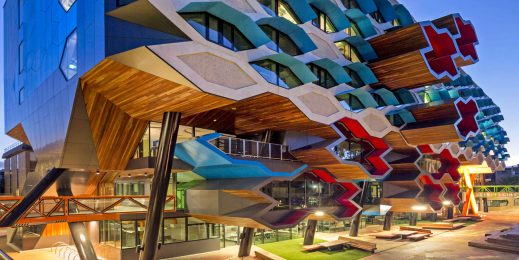
Digital Transformation
Victoria’s Supreme Court using Cloud as a strong foundation for its future
The Supreme Court of Victoria is undertaking an important digital transformation to improve the efficiency and accessibility of the justice system.
Judges first took their seats on the bench of the Supreme Court of Victoria in 1841. Today the Court employs around 450 staff and 60 Judicial Officers, operates 34 courtrooms and deals with the State’s most serious criminal and complex civil matters.
Pauline Diano, Program Director – Digital Strategy, at the Supreme Court explains; “Our digital transformation is a ground-up rebuild of the entire network infrastructure and an end-to-end digitisation of the complete case workflow for all matters within the Court, from case initiation, to case management, electronic trials and the interfaces with other agencies and parties.”
The Court has deployed new network infrastructure, upgraded and rebuilt the Court’s case management system in Microsoft Azure, transitioned to Office 365, SharePoint Online and implemented Express Route to further boost performance. It has also rebuilt citizen-facing platforms such as electronic filing, Probate Online and is in the process of relaunching its more user centric website in Azure. The program is also delivering a full upgrade of all the in-court AV technology to the Court’s 34 courtrooms.
Diano says that running the Court using the cloud injects flexibility, agility and scalability. Increasingly, we are able to respond rapidly to the dynamic needs of the Court. With the upgrade of the Court’s physical in-court technology, the ability to live-stream many matters at once and have multiple remote witnesses at once is no longer dependent on having built the peak physical infrastructure to run it. In Azure all the time it takes is to turn on those servers – and we only pay for what we use”, says Diano.
That agility and responsiveness in Courts is unprecedented globally.
– Pauline Diano
“The whole program of work covers the lifecycle of a case including trial and Microsoft products are at the heart of the solution.”
The proof of concept for the revamping of the courtrooms to capture both audio and video content is slated for mid-2018, with roll out across the Court thereafter.
“The $11 million in-court technology upgrade will see devices such as Surface Studios on the bench for the Judge’s interaction with the electronic court file. “
Courting the cloud
Until 2015 the Supreme Court of Victoria shared a computer network and infrastructure with the Victorian Department of Justice and Regulation (DJR), but the opportunity to move to a more agile, modern cloud environment, spurred a decision to create an independent technology environment that would form the foundation for ongoing innovation.
Diano took over the management of the digital strategy and implementation in July 2015.
Working closely with the DJR and the Victorian Government’s IT provider Cenitex to establish a gateway between key information systems Diano and her team have achieved a secure connection for the Court to access DJR corporate applications.
When the Court shared the DJR’s network it was limited to running an older version of Equivant CourtView case management system. Migrating that to Azure has allowed the Court to use the current version of CourtView and turn on additional functionality such as electronic filing.
The case management system is now also integrated with SharePoint for document management, replacing an older proprietary document management system. The electronic court file and the dashboard for Judges has also been developed in SharePoint.
“It has all been pretty smooth sailing and adopted quite enthusiastically by the Court,” says Diano.
Automating and streamlining the previously manual and largely paper-based process injects further efficiency and reduces the risk of paperwork being misplaced or overlooked.
True transformation
Working with Microsoft and Microsoft partners Acclimation and Ensyst has allowed Diano and her team to successfully address technology challenges. The bigger hurdle was logistical.
“The migration of judges from one network to another was logistically quite difficult because there is not that much downtime in which to roll out for major changes in a modern busy court. Matters are accessible 24/7 and emergency matters can arise at any time.
“That’s certainly not a challenge from a technical point of view because we have rebuilt everything in the most contemporary environment available to us with the help of qualified partners.” Systems resilience is assured through the 3km Express Route connection to the Azure data centre in Melbourne with disaster recovery via Azure Sydney.
Diano’s team of nine people has also been carefully constructed to ensure successful implementation and change management. The team of technologists and project managers also includes a full time trainer who works one-on-one with Judges in their chambers when a new application or functionality is deployed, also a communications and change specialist whose role says Diano is; “To ensure this is not just a digital transformation but a business transformation.”
The Court is very optimistic about what technology can do to continue to improve the user experience of the Court, improve access to justice and open the Courtroom to everyone regardless of location.
– Pauline Diano
Digital justice
Ensuring improved access to justice is a key driver for the transformation currently underway at the Court, but Diano stresses that this is an ongoing journey.
Besides the focus on streamlined case management Diano has upped the ante on reporting, using Business Objects for a new reporting platform being deployed.
She says that with the digital foundations now in place there is the opportunity for ongoing innovation and continuous improvement.
“We are also working with other Victorian agencies to receive evidence electronically directly from their system to ours. Such evidence can be gigabytes big made up of thousands of scanned pages, photographs and video footage. Flexibility, agility and scale.
With the digital transformation well advanced the Supreme Court is well placed for ongoing innovation – and has achieved it economically and with minimal disruption to the Court says Diano.
“The most tangible benefit of the Azure environment is that it matches the dynamic nature of a court. Matters are scheduled to be heard and can overnight be settled or a guilty plea entered into, so those trials or hearings don’t go ahead. This happens every day and it’s only an environment like Azure that allows you to immediately respond to changing demands.”
“In a physical environment, you have to build and pay for peak which for us running all systems and all courtrooms (with video conferencing, live streaming/webcasting and transcription services) all at once. If we have a full schedule requiring all technology services then we have to build and maintain the capability to run all 34 at once even though that may happen only a few times a year.”
“Azure allows you to spin up the servers you need as and when you need them, then wind them down when you don’t – only paying for what you use.”
“We wouldn’t get that in a different environment – that is at the heart of this story.”
“We are in a position where we can immediately address the real needs of this environment which varies day to day.”
“What sort of environment is going to give us that level of flexibility and scalability? That is at the core of why this whole digital transformation is perfect for the Supreme Court.“
















